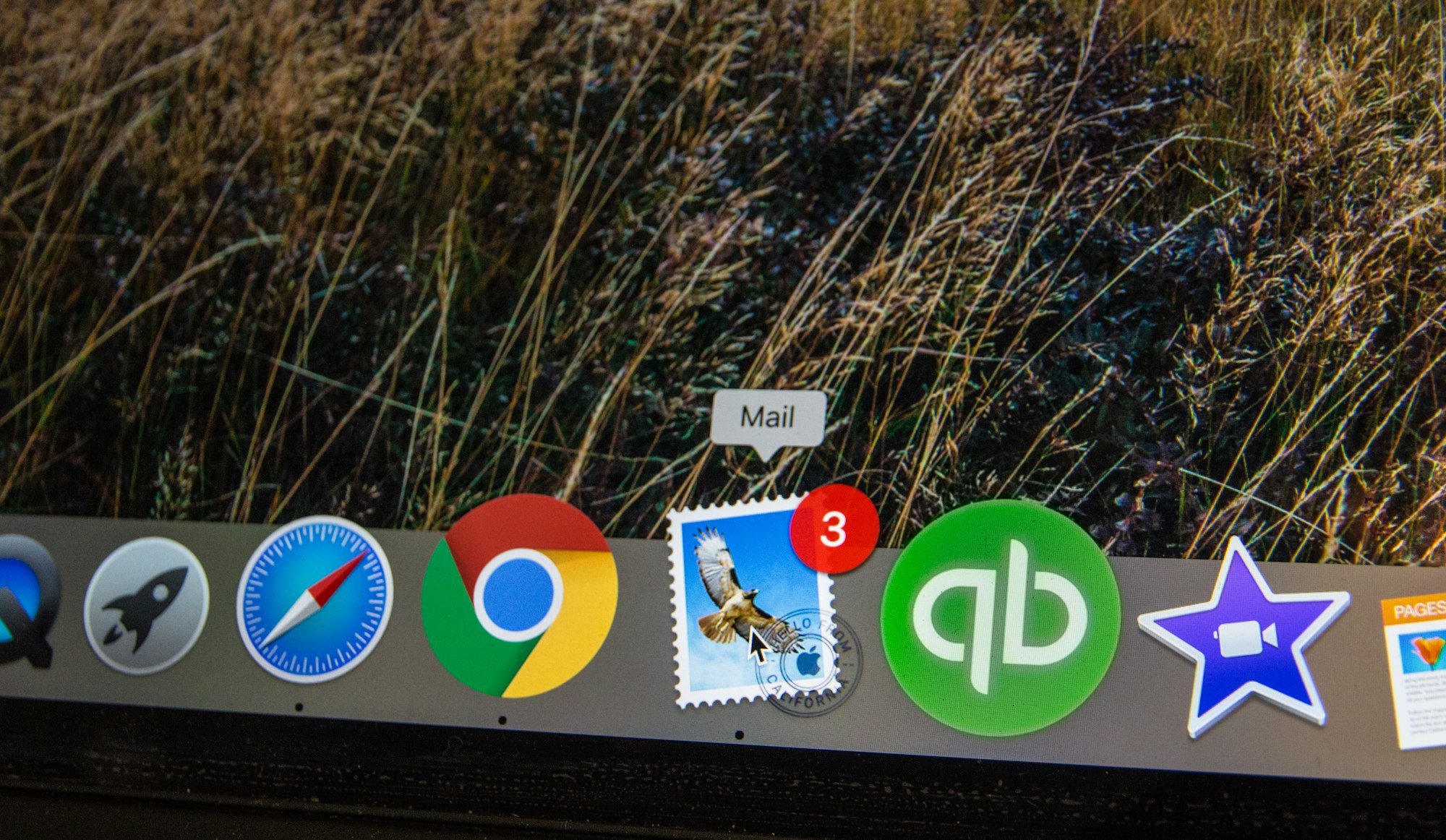Unless you’re a 5-year-old at a playground, friendships usually form over time. Bonds emerge from mounting interactions and shared experiences. Think of email subscribers as prospective friends of your ecommerce brand and email marketing as the relationship-forming driver.
Email marketing has the potential to foster the customer journey and build rapport like no other marketing endeavor can. Not a spectacularly designed website, a viral social post, or clever advertising.
Trust equals sales. Email marketing surpasses all other marketing channels in driving purchases. So how do you squeeze the most out of this cost-effective, ROI-impressive tool to grow your ecommerce business? Let’s explore five steps for using email to nurture interest and win customer loyalty.

1: Build your email list
The first step to business growth through email is gathering an audience.
Cultivating a list to receive your ecommerce email marketing is a continuous effort. You need to constantly attract newcomers to expand your reach and replace the subscribers who inevitably leave or become disengaged.
List-building tools
Use a multi-pronged approach to feed your list growth engine. Consumers find you in multiple ways, so be ready for them. Consider these tools for capturing interest:
- Prep your website. The goal is to gain zero-party data from visitors before they walk away. Website forms and email popups are fantastic for collecting emails. Add an extra field to gain further data for future personalization efforts, like Brilliant Earth does.
- Leverage social media and ad campaigns. Encourage followers to subscribe for exclusive offers and extra content. Send ad clickers to your site (which has an email popup) or landing page with an offer unlocked upon email signup.
- Collect emails in person. Whether you have a brick-and-mortar location or attend popup events, ask for emails to support your ecommerce operation.
- Add a signup option at checkout. Build loyalty with first-time customers by enabling email marketing signup at checkout.
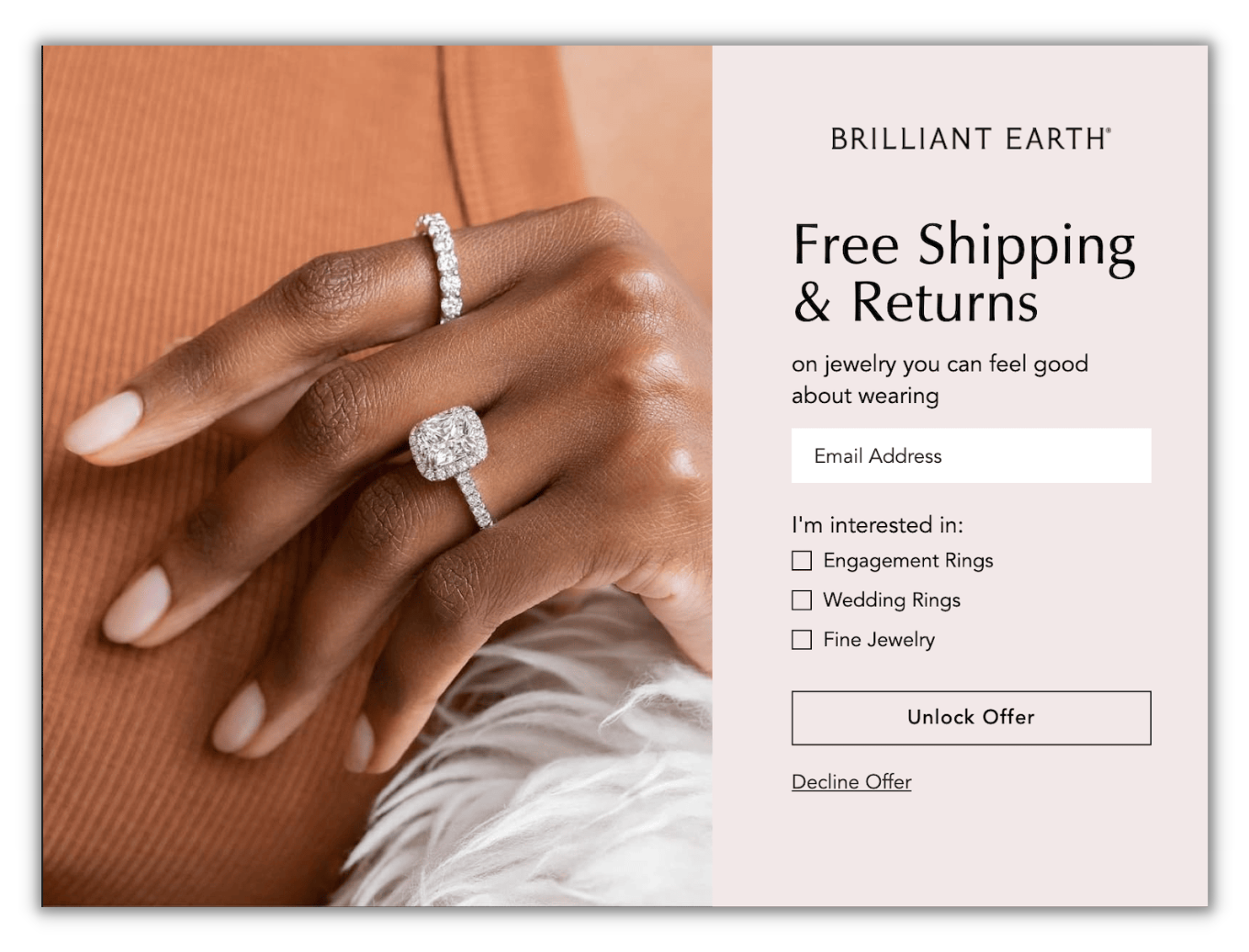
Never buy an email list. Purchasing one violates the core tenet that email marketing is a permission-based channel. You’re asking for a rise in complaint rates, which puts your email deliverability in peril.
Incentives
If you’re asking someone to share their email — and more — you need to give something in return. Common incentives include:
- An immediate win, such as a welcome discount, free shipping, or valuable content like a style guide
- A prize entry
- A promise to regularly update subscribers with offers, unique content, or exclusive deals

2: Engage with compelling email newsletters
Thought and strategy form the bedrock of successful email marketing programs. We could talk about a slew of best practices, but we’ll focus on the three most essential elements: email design, sending cadence, and content.
Email design
We appreciate email marketing masterpieces crafted by graphic design pros. But we equally admire those producing sleek emails without the same caliber of talent.
The simplest of email designs can be the most powerful. The best-converting newsletters adhere to an email marketing anatomy void of clutter and feature four components:
- An enticing headline
- An eye-catching hero image
- A balanced ratio between images and concise copy
- At least one call to action (CTA) button directing subscribers to the next step
The ecommerce email example from Function of Beauty shows the effectiveness of simplicity.
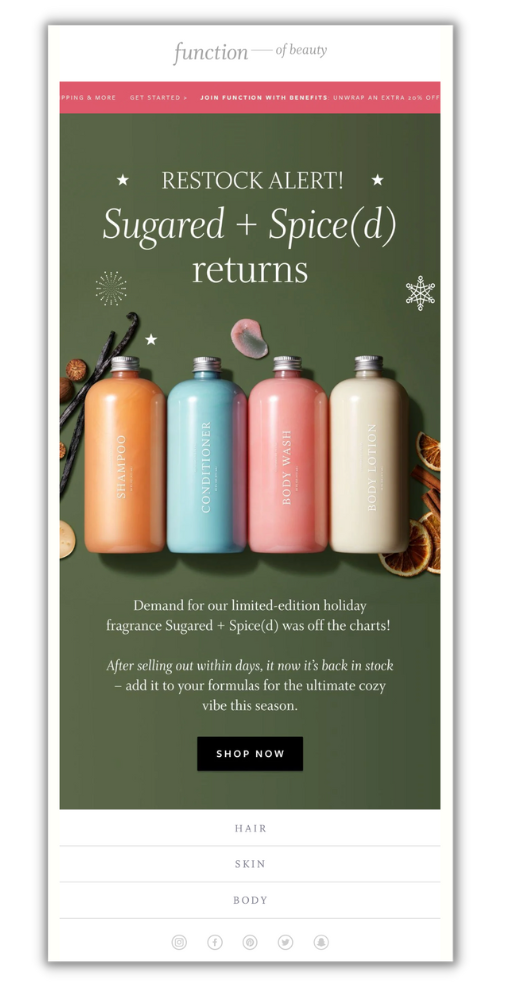
Email sending cadence
Email marketing frequency matters. You’ll lose recognition from subscribers by sending too little. Email them too much, and you’ll drive them away (over-sending is the leading cause of unsubscribes).
The right cadence is unique to each brand, determined by product inventory size, customer base preferences, team capability, and other factors. Pick a consistent schedule you can maintain. If it’s as little as twice a month, that’s OK.

Content
Give subscribers a reason to open your emails by creating varied, valuable content. Intermix sales promotions with deeper dives into the value propositions of bestsellers, peeks behind the scenes, and educational how-tos. Paravel, for example, instills trust with its user-generated content email example featuring customer testimonials.
3: Nurture with email automations
Every email marketing program needs automations — messages triggered when subscribers take a specific action — for two reasons:
- They work behind the scenes with comparatively little upfront work.
- They’re integral to connecting with subscribers at key lifecycle touchpoints. In other words, your brand shows up at the important times.
You can do a lot of nurturing with various customer lifecycle workflows. At a minimum, implement the three must-haves for ecommerce email marketing: welcome, abandoned checkout, and post-purchase automations.
Welcome email
Anyone who subscribes to your email list deserves a proper greeting. A welcome email automation kicks the relationship off on the right foot. Plus, subscribers expect it, especially if you promised an incentive.
Hive & Heath’s version is simple yet inviting.
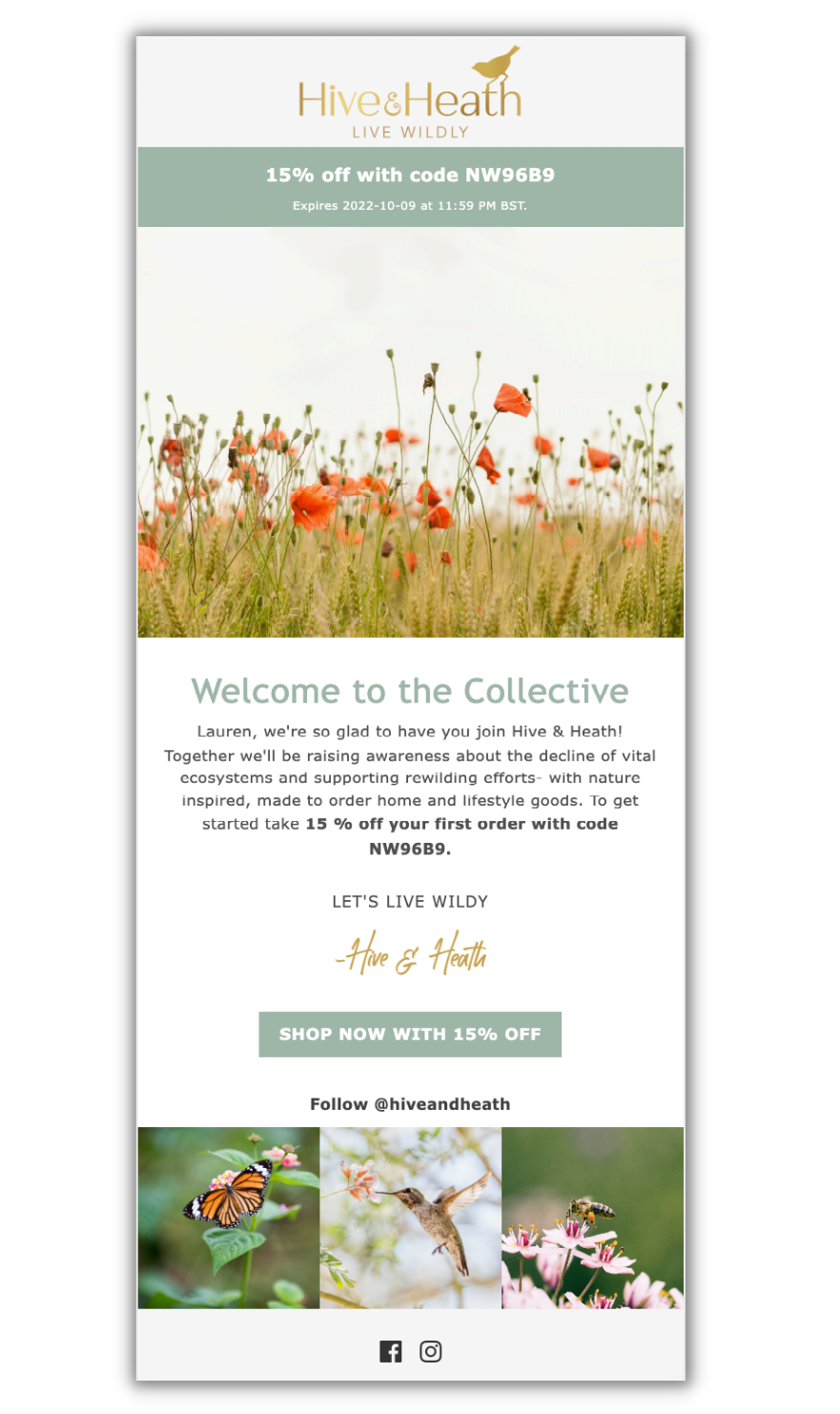
Expand your automation to a series for deeper engagement. One email could focus on bestsellers, another on introducing your social channels, and the last on a discount reminder if it hasn’t been redeemed.
Abandoned checkout email
Shoppers frequently load online carts with products, make it to checkout, and disappear. An abandoned checkout automation helps you capitalize on interest and recover some of the lost sales.
Offering a discount is a common tactic, but we think it’s best to save it for the final message in a series must. Start, instead, with an approach like Vellabox.

Post-purchase email
You’ve made a sale. Now what? Follow up with a post-purchase email automation. It can be a small gesture like “thanks for supporting us” or a tailored care guide for the product purchased. Post-purchase emails are vital for supporting customer retention. They convey to customers that they’re not just another number.
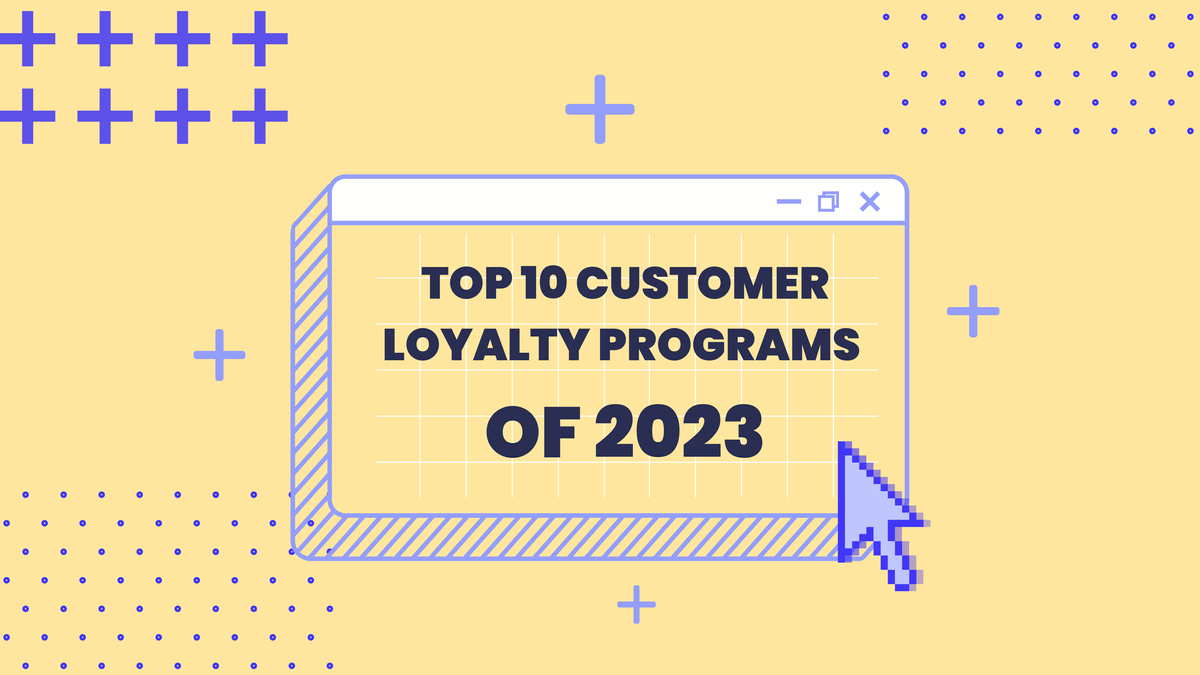
4: Personalize with segmentation
If automations nurture through broad personalization, segmentation forges stronger connections through elevated personalization. Personalization repeatedly appears as a consumer priority in research studies. One report shows that 71% of consumers expect it from brands.
If any marketing channel can deliver on personalization, it’s email marketing. With every subscriber you collect and email you send, you generate data. Data is integral to identifying segments worth targeting.
Examine your list through multiple lenses. You could create email segments and tailored messages based on the following:
- Habits and behaviors, such as email engagement and purchase history
- Interests, such as categories browsed
- Demographics, such as place of residency
The point is to speak more directly to your subscribers’ motivations and preferences. Ecommerce email marketing that relates to subscribers demonstrates that you understand them and care about their needs.
5: Improve with performance metrics
The best ecommerce email marketing programs are works in progress requiring regular evaluation. Otherwise, how do you know if your efforts have the intended effect?
It’s OK to peek at performance after sending every newsletter, but the more helpful exercise is detecting trends over an extended time. Periodically reserve time to audit your email metrics for newsletters, automations, and segmented emails. Pay attention to:
- Open rates: Are your email subject lines compelling?
- Click-through rates: Does your content spark action?
- Bounce rates: Does your content resonate?
- Conversion rates: Are there friction points between the email and your site?
Use your findings to improve your email marketing, from tweaking a lackluster automation to refining your overall strategy. Test and repeat.
Embrace the power of email marketing
Email marketing can be a significant lever in fueling ecommerce growth when approached with intention.
The best outcomes result from:
- Continuous list growth
- Newsletters that resonate with your audience
- Automations that carry some of the relationship-building load
- Segmenting for improved targeting precision
- Using metrics to inform adjustments
Once you have the right email marketing app to conquer your growth goals, take full advantage of its power to connect with your audience meaningfully, foster brand loyalty, and boost sales.
Tracy Puckett is Content Manager at Seguno Software, the top-rated email marketing platform built exclusively for Shopify. Tens of thousands of merchants choose Seguno to save time, send better, and earn more — without leaving Shopify.

